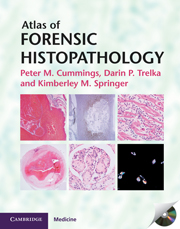Preface
Published online by Cambridge University Press: 05 August 2013
Summary
This atlas was a labor of love as much as it was a labor of practicality. Forensic pathology is one of those disciplines which, although recognized for over fifty years, has little in the way of literature, in contrast to many of its bigger brethren in anatomic pathology. As such, we found that it is often difficult to find well-presented, clear, and visually compelling forensic micrographs for correlation with what we were finding through our microscopes during slide review. In addition, as one practices this craft, one often finds oneself faced with questions asked by law enforcement officers and agents of the legal system for which anatomic pathology residency programs have not prepared us: “How old is this bruise?”, or “…so was the fetus dead before the assault?” It is often enough that the answers to these questions can be found in articles spread out across the literature of the last 10 or 20 years, but the question which remains is whether trainees are aware of this literature and how can it be made more accessible?
In order to address these issues, we all began to build a literature library which we use in our daily practice. This atlas is a product of that library as a reflection of the needs we felt during forensic fellowship training and the first few years of our practice. We think it to be a concise collection of micrographs and descriptive tables of forensic interest, which we have incorporated into our respective practices. It is our hope that this will be a “scope side” referent for trainees in forensic medicine and as a review for forensic pathologists already in practice.
- Type
- Chapter
- Information
- Atlas of Forensic Histopathology , pp. xi - xiiPublisher: Cambridge University PressPrint publication year: 2000



